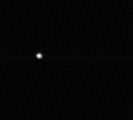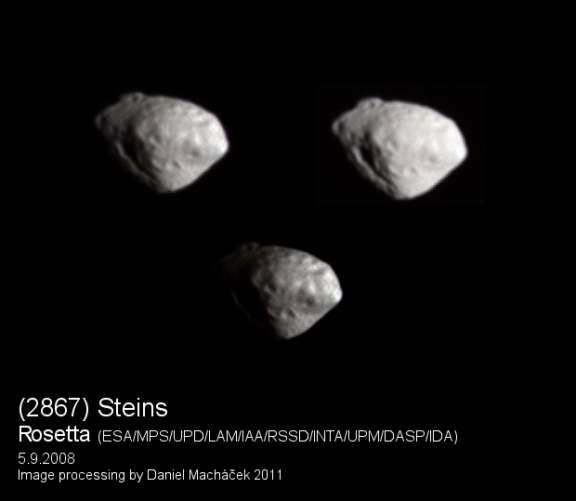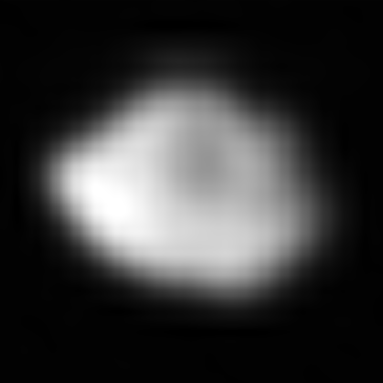Emily Lakdawalla • Jun 13, 2012
Steins, a jewel in the asteroid belt
The USGS recently announced a new set of names for craters and features on asteroid 2867 Steins. As with names on all worlds in the solar system, there's a specific theme for names on Steins, and it's a play on the jewel-like shape of the asteroid. According to the USGS planetary nomenclature website:
- Craters on Steins are to be given names of gemstones;
- Regiones (of which there appears to be only one) are named for the discoverer of Steins;
- Other features (of which none appear to be named just yet) will be given names of places associated with gemstones.

These new names piqued my curiosity about the images of Steins acquired by Rosetta's OSIRIS camera instrument. The flyby was quite a while ago, on September 5, 2008, but the data only became available in July of last year, and I didn't have time to examine the data set at the time. Now I have a spiffy new website to play with, so I figured it was a good time for me to plunge into a new data set.
You can get the Steins data in a couple of places; I downloaded it from the Small Bodies Node of the Planetary Data System and ran them all through IMG2PNG to convert them to a format friendly to Photoshop. This is a small data set as such things go, only about 1000 images. Of those, fewer than 400 show the asteroid as more than a speck. The small number arises in part from it being a fast flyby of a small object; there was really only an hour of decent imaging, from 17:54 to 18:49. But it's also because of a sad circumstance: one of the two cameras, the higher-resolution Narrow-Angle Camera, went into safe mode 10 minutes before closest approach. That was unfortunate for two reasons. The obvious reason is that the Narrow-Angle Camera has roughly five times better resolution than the Wide-Angle Camera, so it could have achieved much more detailed imaging of the asteroid, had it been operating through closest approach. The other reason will take some explaining, which I'll do in a minute.
I made a list of all the images taken during the encounter, with links to JPEG versions hosted by the Small Bodies Node. One of the first things I realized is that there are several different times of closest approach mentioned in various places on the Web, but according to the spacecraft's clock, closest approach occurred at about 18:38:14 UTC, with the highest-resolution image being acquired at an altitude of 801.8 kilometers. I was also reminded that an essential step in processing OSIRIS image data is to mirror the images (that is, flip them left-for-right or top-for-bottom). Also, despite the orientation of the maps above, the pointy end of the "jewel" is actually the north pole; I oriented the images with north up.
I looked first at the Narrow-Angle Camera images to see what was there. This is the entirety of the Narrow-Angle Camera data set, at its full resolution:

It's sort of fun to animate these.

The last set of five images includes the ones necessary to make a true-color portrait. So I put them together, and, honestly, I do not see any evidence for any color variation across the surface at all. All of the color variation in my image arose from a mismatch between the different color channels and not from any actual color differences. So rather than show you my terrible color image, I'll show you what Daniel Machacek made of this data set when it came out last summer:

So much for the Narrow-Angle Camera images. Here, then, is a selection from the much larger Wide-Angle Camera data set, with a selection from the Narrow-Angle Camera data set as the top row. By coincidence, the highest-resolution Wide-Angle images are similar in resolution to the best Narrow-Angle image, so we have two similar-resolution views of both faces of Steins, the one seen on approach and the one seen on departure. A curious thing happens in the third row of images, where Steins brightens to a brilliant white and almost all detail vanishes. What happened there is that Rosetta passed pretty much right between the Sun and the asteroid; in geometric terms, Rosetta saw Steins at zero phase. All shadows disappeared as Rosetta looked directly down.

With such a sequence, the most obvious thing to do is to combine them into an animation. Love that zero-phase flash. The version below contains only a couple of the images; click to reach a version that has all of them. I didn't bother to align them here; you can see how well Rosetta autonomously tracked the asteroid. That's a well-behaved spacecraft, even if its Narrow-Angle Camera did shut its eye prematurely.

I looked for ways to combine these into color images, but I couldn't make a good one, and here's one reason why. If you look at my chart listing the OSIRIS camera filters, you'll see that although the Wide-Angle Camera does have color filters, they are not the kind used for studying geology or for capturing true-color portraits. They are very narrowband filters covering certain lines in an emission spectrum. They're designed to search a comet's coma for the telltale emission lines from different gaseous species like OH, CN, and the like. There is nothing anything like a blue filter, and while there are medium-band red and green filters, they weren't used during the Steins encounter. Most of the images were taken through the OI filter, a very narrowband one at a red wavelength; I am guessing, but do not know for sure, that one reason for this is that Steins is much brighter than the comet nucleus will be (having higher albedo and being closer to the Sun), so they had to use a narrowband filter just to stop down the amount of light getting into the camera, and the OI one was a good match for the orange filter that they chose for viewing the nucleus with the Narrow-Angle Camera.
So what to do with these data? I decided to try to understand Steins' shape better by making a rotation movie. I selected a subset of Narrow- and Wide-Angle Camera images spaced somewhat evenly in time, resized them all to a common scale, and aligned them. I'm pretty pleased with the result; Steins really does appear to be a rotating jewel, throwing off glints of light as it spins. One glint is from the passage through zero phase; the other is from the sudden step down in resolution from the last Narrow-Angle image to the first Wide-Angle one.

How about the rest of you? What can you do with these images?
Support our core enterprises
Your support powers our mission to explore worlds, find life, and defend Earth. You make all the difference when you make a gift. Give today!
Donate

 Explore Worlds
Explore Worlds Find Life
Find Life Defend Earth
Defend Earth

